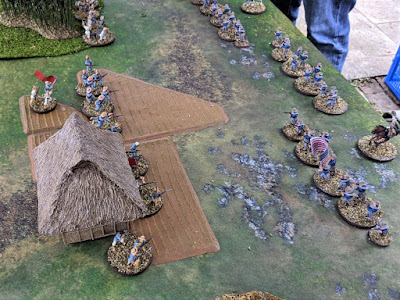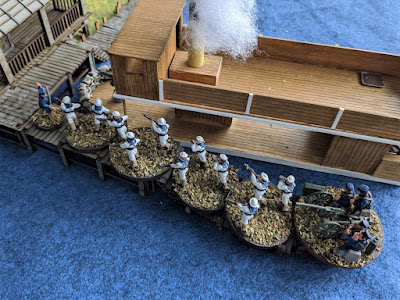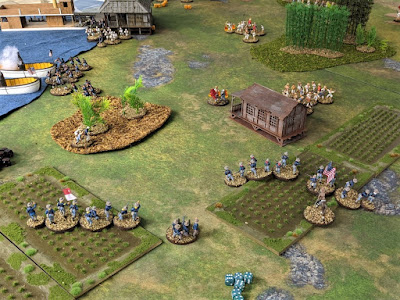The weekend weather forecast was for warm sunny weather, so we planned to take advantage of the good weather to get in a bonus outdoor game. While the weather did not meet the forecast, we did get in the game. This time we brought out a blast from the past with Mark Waddington's scratch-built War of 1812 Lake Ontario ships.
The ships made their last appearance at DANG 2012 and it seemed like time to pull them out again. This time we decided to try out the Form Line of Battle rules, using the Small Actions modifications for small and unrated ships.
 |
The British (left) and American (right) lines set up for action
|
The scenario had four ships from the British Lake Ontario squadron returning to their base at Kingston while five American ships moved to cut them off and force a battle. The Americans had a corvette (Madison), a brig (Oneida), and three schooners (Sylph, Scourge, and Hamilton).
 |
American ships Madison (left) and Oneida (right)
|
 |
American schooners (L-R) Sylph, Scourge, and Hamilton
|
The British had two corvettes (Wolfe and Royal George) and two schooners (Sir Sydney Smith and Beresford). The British ships were only armed with carronades, although most had some bow and stern chase long guns. Most of the Americans also had carronades, but Sylph and Scourge both had long guns as their main armament, with Sylph have three 32 pound cannons on pivot mounts.
 |
British line looking from the aft.
|
In Form Line of Battle (FLOB), each side has three phases - a Command Phase and two Action Phases. During the Command Phase a side carries out all their administrative tasks, such as reloading guns, fighting fires, cutting away fallen masts, and so on. In the Action Phases ships move, turn, and shoot, but a ship can only fire broadsides once per turn. The order of the phases is determined by card draw, with the first card draw for a side always being the Command Phase. This can lead to some interesting situations where one side gets to reload, move and shoot before the other side can reload. Additionally, movement distance is randomly determined per ship by rolling a number of D6 dice based on the ship's position to the wind. The ship can move the total of the dice or the distance of one die. The randomness of movement range makes it harder to keep ships in a line and the random movement order makes it tougher to plan your action. But, as I said, it does make for an interesting and unpredictable game.
With our game setup, we started out with the British moving slow and trying to keep their line together. The American lead ship (Madison) rolled well for movement and decided to move quickly to block the British exit. The second ship (Oneida) tried to keep up, but this left the American schooners behind.
 |
Madison blocking the way
|
With most of the ships armed with short-range carronades, the British decided turn on the schooners.
 |
The lead British ships (mid-left) turn toward the American schooners
|
They were able to close with the smaller schooners and hammer away at Sylph, causing the schooner to strike.
 |
Sylph strikes after being blasted
|
The larger American ships were too far was to stop the attack, but quickly turned to close with the British.
 |
Oneida watches as Sylph strikes
|
The schooner Scourge, after seeing what happened to Sylph, sped past the ships. But Hamilton's movement rows did not turn out as well, leaving her too close to the enemy as the British schooners caught up with the action.
 |
Hamilton (center near the struck Sylph) in the middle of the British
|
Long-range (for carronades) fire from the larger American ships continued to concentrate on the Wolfe, the lead British corvette. But Wolfe was having problems of her own. In the FLOB rules you have to make a roll during the Command Phase to reload your broadsides and Wolfe had failed all reload attempts. So while she was doing good service by providing a target for the Americans, she was not doing any damage in return (Yes, I was running Wolfe and rolling badly).
On the next turn Hamilton took the brunt of fire and struck too. But the British line was somewhat disorganized, with every ship acting on its own.
 |
Hamilton strikes after taking heavy damage
|
Madison and Oneida were still doing a good job of blocking the British exit. The British were not in good positions to support each other.
 |
Madison and Oneida (upper left) and Scourge (upper center) block the channel
|
Wolfe (damaged and still with unloaded guns) tried to make a run for the harbor, using one of the islands as a shield.
 |
Wolfe tries to limp away
|
Madison and Oneida blasted the British schooner Sir Sydney Smith and then turned to catch Wolfe. Wolfe finally reloaded her much diminished broadside, but the random turn order allowed the Americans to move and shoot first, finishing off British corvette.
 |
Wolfe loses the last of her hull and strikes
|
The action was starting to wind down, but the American schooner Scourge and British schooner Beresford were still fighting it out. Scourge did get in front of Beresford, getting in one last shot before losing her last hull and striking.
 |
Scourge gets in one final shot
|
At this point Royal George and Beresford decided to escape off the map, ending the game. The British lost two ships, one corvette and one schooner, and the others were damaged. The Americans lost three schooners and the brig Oneida was moderately damaged, but Madison was pretty much unscathed.
 |
Madison and Oneida watching the retreating British
|
Overall, it was a fun game, even with my bad die rolling, and it was nice to get in a bonus outdoor game. The FLOB rules were easy to pick up and had some interesting twists. After the game we talked about using some of the Warlord Games Black Seas ships with the rules.





































































